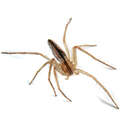en
names in breadcrumbs


The spider family Philodromidae (running crab spiders) includes 542 described species, nearly a hundred of which are known from North America north of Mexico (Philodromus dispar is native to Europe and Central Asia, but has been introduced to the United States and Canada) (Platnick 2013).
Philodromids are two-clawed, flat-bodied, somewhat crab-like hunting spiders (Dondale 2005). Like thomisids, many species hold their legs in a laterigrade position (i.e., the legs extend sidewise and the femora, especially, are twisted so that the front surface faces up). The eight eyes are at the front of a narrow cephalic region (i.e., the forward part, or "head" region, of the cephalothorax) and the cephalothorax is broad and often as wide as it is long. These spiders were formerly considered to comprise a subfamily of Thomisidae, but Homann (1975, cited in Dondale 2005) concluded that they were independent of the thomisids, a finding confirmed by the molecular phylogenetic analysis by Benjamin et al. (2008). In comparison with philodromids, thomisids tend to have more compact and globose bodies, with thicker legs; raptorial spines on the first pair of legs; prominent eye tubercles ("bumps"); and no claw tufts or scopulae, or distinct brushes of hair, on their legs.
Philodromids lead an active predatory lifestyle on plant stems and leaves. Some are found only on coniferous trees, others only on deciduous trees; a small number live in deserts. Life histories have been studied by Dondale (1961) and Putnam (1967) and Haynes and Sisojevic (1966) studied predatory behavior. Dondale (1964, 1967) used courtship behavior to distinguish some closely related species.
(Dondale 2005; Bradley 2013)
Philodromidae, also known as philodromid crab spiders and running crab spiders, is a family of araneomorph spiders first described by Tord Tamerlan Teodor Thorell in 1870 (then known as subfamily Philodrominae within Thomisidae).[1] It contains over 500 species in thirty genera.[2]
The most common genus is Philodromus which is widespread, similar to Ebo.[2] Other common genera include the elongate grass-dwelling Tibellus and the widespread Thanatus, which includes the house crab spider that commonly captures flies on and in buildings.[3]
Philodromids have a crab-like shape due to the first two pairs of legs being oriented sideways (laterigrade).[4] This is superficially similar to the "true" crab spiders (Thomisidae), such as Misumena vatia, but these families are not as closely related as previously thought.[5] Unlike crab spiders, the legs are generally similar in size, though the second leg pair may be significantly longer than the first pair.[4][5] This is most evident in Ebo, where the second pair of legs are twice as long as the first pair in some species.[5] Philodromids have scopula only at the tips of the tarsi (unlike sparassids) and the eyes are in two curved rows with the posterior row wider than the anterior row.[4] In terms of colouration, they are usually cream to light brown and have faint longitudinal stripes.[6]
Philodromidae are active predators and often occur on the stems and leaves of plants.[7] Some occur only on deciduous trees and others only on conifers.[7] A small number of species live in deserts.[7] Instead of building webs to catch prey, they hunt by ambush.[6]
As of April 2019, the World Spider Catalog accepts the following genera:[2]
Philodromidae, also known as philodromid crab spiders and running crab spiders, is a family of araneomorph spiders first described by Tord Tamerlan Teodor Thorell in 1870 (then known as subfamily Philodrominae within Thomisidae). It contains over 500 species in thirty genera.
The most common genus is Philodromus which is widespread, similar to Ebo. Other common genera include the elongate grass-dwelling Tibellus and the widespread Thanatus, which includes the house crab spider that commonly captures flies on and in buildings.